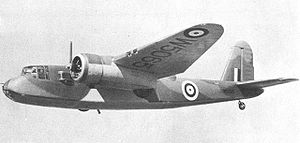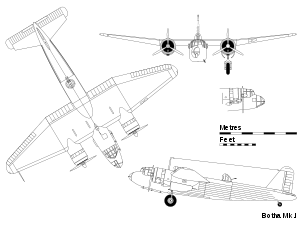Blackburn Botha Videos - Picture

|
|
Blackburn Botha
B.26 Botha

Picture - Blackburn B.26 Botha
Role: Torpedo bomber
Manufacturer: Blackburn Aircraft, Dumbarton
First flight: 28 December 1938
Introduced: 12 December 1939
Retired: September 1944
Primary user: Royal Air Force
Number built: 580
The Blackburn B.26 Botha was a British four-seat reconnaissance and torpedo bomber. It was built by Blackburn Aircraft at their factory at Dumbarton, Scotland, as a competitor to the Bristol Beaufort, and entered service with the RAF in 1939. It was underpowered and was quickly withdrawn from operations.
History
In September 1935, the British Air Ministry issued specification M.15/35, for a three-seat twin-engined reconnaissance/torpedo bomber. Two submissions to met this requirement were accepted, from Blackburn for the Botha and the Type 152 (later known as the Beaufort) from Bristol. Both were intended to use the 850 hp (634 kW) Bristol Perseus engine. The Air Ministry later revised the Specification to M.10/36, which required a crew of four. The weight increase meant that both designs required more power. The 1,130 hp (840 kW) Taurus was provided for the Beaufort, but the Botha received only the Perseus X of 880 hp (660 kW).
The Air Ministry ordered 442 Bothas in 1936, while also placing orders for the Beaufort. The first flight took place on 28 December 1938. The RAF received its first delivery in December 1939, entering squadron service with No. 608 Squadron RAF in June 1940, the only squadron that would use the Botha operationally, the Botha being used for coastal patrols carrying 100 lb (50 kg) Anti-submarine bombs or 250 lb (110 kg) GP bombs.
In service, the Botha proved to be severely underpowered and unstable and there were a number of fatal crashes in 1940. Both airframe and engine were subject to further development work, but it was decided to withdraw the type from front-line service. At this point, the Air Staff made the ill-advised decision to transfer the surviving aircraft to training units, which inevitably resulted in further casualties.
Some Bothas were converted to target tugs and re-designated TT Mk.I.
The type was finally retired in September 1944. In total, 580 aircraft were built.
Variants
Botha Mk I : Four-seat reconnaissance, torpedo bomber aircraft.
Botha TT Mk I : Target tug aircraft.
Operators
United Kingdom
Royal Air Force
No. 3 School of General Reconnaissance
No. 24 Squadron RAF
No. 301 Polish Bomber Squadron
No. 304 Polish Bomber Squadron
No. 502 Squadron RAF
No. 608 Squadron RAF
Specifications (Botha Mk.I)

Picture - Orthographic projection of the Botha, with inset detail showing the asymmetric nose glazing.
Data from The Hamlyn Concise Guide to British Aircraft of World War II
General characteristics
Crew: 4
Length: 51 ft 1.5 in (15.58 m)
Wingspan: 59 ft (17.98 m)
Height: 14 ft 7.5 in (4.46 m)
Wing area: 518 ft² (48.12 m²)
Empty weight: 11,830 lb (5,366 kg)
Max takeoff weight: 18,450 lb (8,369 kg)
Powerplant: 2x— Bristol Perseus radial engine, 930 hp (694 kW) each
Performance
Maximum speed: 216 kn (249 mph, 401 km/h)
Cruise speed: 184 kn (212 mph, 341 km/h)
Stall speed: 65 kn (75 mph, 120 km/h)
Range: 1,100 nmi (1,270 mi, 2,044 km)
Service ceiling: 17,500 ft (5,335 m)
Armament
3 x— 0.303 in (7.7 mm) machine guns (one fixed forward-firing, two in dorsal turret)
internal torpedo, depth charges or bombs up to 2,000 lb (907 kg)
Comparable aircraft
Bristol Beaufort
Bibliography
Air Transport Auxiliary Ferry Pilots Notes (reproduction ed.). Yorkshire Air Museum. 1996. ISBN 0-9512379-8-5.
Jackson, A.J. (1968). Blackburn Aircraft since 1909. London: Putnam & Company Ltd.. ISBN 0-370-00053-6.
Mason, Francis K. (1994). The British Bomber since 1914. London: Putnam & Company Ltd.. ISBN 0-85177-861-5.
Mondey, David (1994). The Hamlyn Concise Guide to British Aircraft of World War II. London: Aerospace Publishing. ISBN 1-85152-668-4.
Wixey, Ken (1997). Forgotten Bombers of the Royal Air Force. Arms & Armour Press. ISBN 1-85409-306-1.
Blackburn Botha Pictures and Blackburn Botha for Sale.
Living Warbirds: The best warbirds DVD series.
Source: WikiPedia